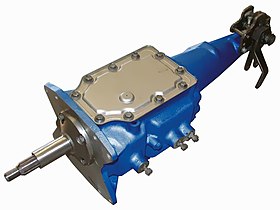| Toploader Transmission | |
|---|---|
 | |
| Overview | |
| Type | 3 or 4-speed manual |
| Manufacturer | Ford Motor Company |
| Also called | Ford Design 4-Speed 3.03 Top Loader |
| Production | 1964–1973 |
| Chronology | |
| Predecessor | Borg-Warner T-10 Dagenham 4-speed |
A Toploader transmission is a manually shifted gearbox design built in three-speed and four-speed configurations, introduced in 1963 by the Ford Motor Company to replace the BorgWarner T-10. It was used in most Fords and Mercurys from 1964 until 1973, as well as in some foreign models, and is officially designated the 3.03 three speed or Ford design four speed. The designation 3.03 is the centerline distance between counter shaft and mainshaft. The Toploader got its name from the fact that the access plate to the inner workings was located on the top of the main case, as opposed to side access on most gearboxes it would be compared with, such as the Ford Dagenham or GM's Saginaw or Muncie. Distinguishing the three speed from the four is as simple as counting the fasteners on the top plate: the four speed has ten fasteners; the three, nine. Both the three and four speed top loader gearboxes were designed to function in constant mesh, due to synchronizer sleeves being used instead of sliding gears, and be fully synchronized, with the exception of reverse. Forward gears are helical-type, while reverse gear and the exterior of the first and second synchronizers sleeve are spur-type gears. This transmission is also known as the Tremec T-170, HEH, or RUG depending on the year(s) of production.[1] At some point in the early 1970s production of this transmission was moved to Mexico, and the name was changed to Tremec.
- ^ O'Clair, Jim (February 2007). "Ford Toploader Four-speed Transmission". Hemmings Motor News. Retrieved 2010-01-02.